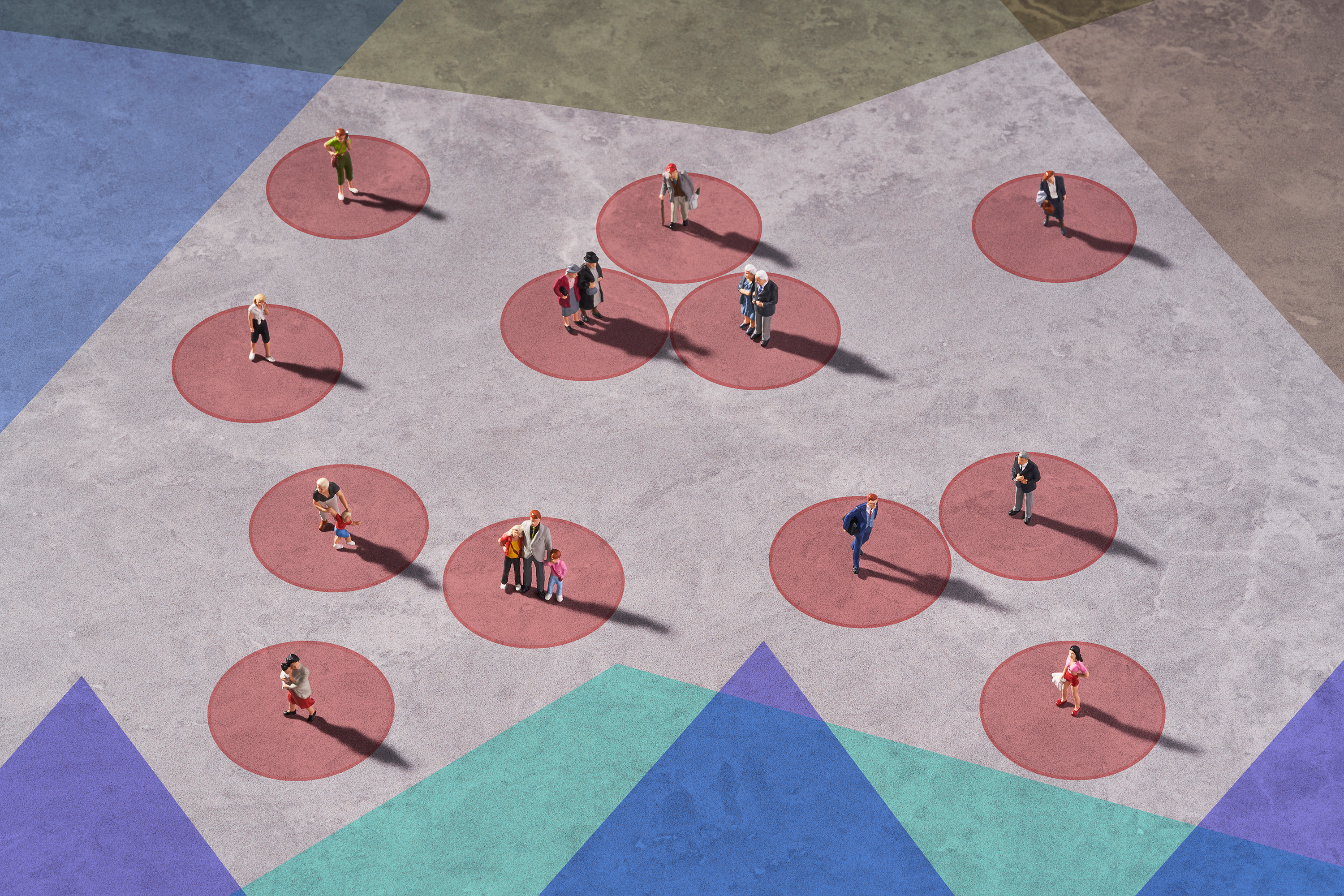What is the new tier system after lockdown and the new rules in the UK?
Wondering what the new tier system will be after lockdown? These are the rules coming in play from when the national lockdown ends on December 2.


With the end of lockdown almost upon us, many people across England are concerned about what comes next - a new tier system? Or another complete lockdown?
The new tier system was finally announced on November 23 by the prime minister, after some days of speculation from the media over what the measures would be when the second lockdown has to come to an end on December 2.
Although he didn't shed much light on how will the new tiers in England be decided or the Christmas lockdown rules, Boris Johnson did confirm what the rules would be in England between now and Christmas Day and possibly beyond.
“I can't say Christmas will be normal this year," He said, but promised that “by maintaining the pressure on the virus, we can also enable people to see more of their family and friends over Christmas.”
“We all want some kind of Christmas, we need it, we certainly feel we deserve it. What we don’t want is to throw caution to the winds and allow the virus to flair up again, forcing us all back into lockdown in January.
The prime minister has yet to release all the details on the new plan and there will be an announcement on Thursday to reveal which areas will go into which tiers. So what is the new tier system after lockdown? What are the current lockdown rules? And what can we expect after December 2?
The new tier system after lockdown in the UK
The new tier system after lockdown in the UK will largely look a lot like the last one, except there are now harsher measures in place for tiers two and three, alongside more support from the government in coronavirus testing.
GoodtoKnow Newsletter
Parenting advice, hot topics, best buys and family finance tips delivered straight to your inbox.
Before Boris Johnson had announced the rules, however, there were discussions over whether the government would add an additional tier, similar to Scotland's 4-tier system as the previous system has been described as largely ineffective by a representative from SAGE. The prime minister followed this report up on Tuesday by saying that the previous tiered restrictions were "not quite enough" so they would be made stricter the higher the tier.
"In recent weeks, families and businesses in England have, once again, steadfastly observed nationwide restrictions and they have managed to slow the growth of new cases and ease the worst pressures on our NHS." The prime minister said, "I can therefore confirm that national restrictions in England will end on 2nd December, and they will not be renewed."
"From next Wednesday people will be able to leave their home for any purpose, and meet others in outdoor public spaces, subject to the Rule of Six. Collective worship, weddings and outdoor sports can resume, and shops, personal care, gyms and the wider leisure sector can reopen."
He added, "But without sensible precautions, we would risk the virus escalating into a Winter or New Year surge. The incidence of the disease is, alas, still widespread in many areas, so we are not going to replace national measures with a free for all, the status quo ante Covid.
"We are going to go back instead to a regional tiered approach, applying the toughest measures where Covid is most prevalent. And while the previous local tiers did cut the R number, they were not quite enough to reduce it below 1, so the scientific advice, I am afraid, is that as we come out is that our tiers need to be made tougher."
What are the rules for tier 3 lockdown?

Tier 3 is still the harshest level of lockdown in the tiered system and it's thought that at the beginning, more areas than before will find themselves here. It comes as areas such as London, Manchester and Birmingham are seeing high numbers of cases still everyday. In tier 3 lockdown, these are the rules that people will have to follow...
- Six people from different households/support bubbles are allowed to meet - but only in outside, public spaces. You're not allowed to meet in gardens etc.
- Pubs and restaurants can only open for takeaway and delivery.
- All non-essential shops are allowed to re-open again.
- Entertainment venues such as cinemas and theatres will be forced to close again.
- There can be no overnight stays elsewhere, unless it's for work or study.
- Places of worship open but interactions with people outside your household or support bubble aren't allowed.
- There can be 15 guests for weddings and wakes. Receptions are not allowed.
- Gyms and all swimming pools are allowed to re-open.
This means that it's not possible to travel during tier 3 lockdown but the exercise rules, with gyms and leisure centres re-opening, are much looser.
What's the difference between tier 3 and a circuit breaker lockdown?
A circuit breaker lockdown like that utilised by Wales and Northern Ireland most recently is different to tier 3 because it contains stricter measures, for a shorter amount of time. For example, during a circuit breaker lockdown, all non-essential shops and leisure facilities like gyms and swimming pools have to close. That's not the case in tier 3 this time, as they are allowed to stay open.
Circuit breaker lockdowns are also often only for a couple of weeks, up to a month, while a tiered system like the one we'll be seeing from December 2 is likely to last a lot longer than that.
What does tier 2 lockdown mean?

Tier 2 is a little less severe but many non-essential establishments like pubs and restaurants can still stay open, but under rules which were previously given to tier 3 areas. These are the rules in tier 2 lockdown:
- Six people from different households/support bubbles are allowed to meet - but only outside.
- Hospitality venues, including pubs and restaurants can re-open but are only allowed to serve alcohol with a substantial meal.
- All non-essential shops are allowed to re-open again.
- Entertainment venues including cinemas and theatres are allowed to open.
- People are allowed to stay over somewhere outside their primary place of residence, such as holiday accommodation or a second home, but only with members of their household/support bubble.
- Places of worship open but interactions with people outside your household or support bubble aren't allowed.
- There can be 15 guests for weddings, receptions and wakes.
- 30 people are allowed to attend a funeral.
- Gyms and all swimming pools are allowed to re-open.
- Community testing like that seen in Liverpool will be made available to all local authorities in tier two.
The prime minister noted that 200,000 people had taken part in the community testing in Liverpool and it had led to a significant fall in infections, so it would now be made available for all those in tier two and three. He added that those towns and regions who engaged in community testing would likely see their restrictions loosened sooner.
What are the tier 1 lockdown rules?

Tier 1 of the system is looking very similar to how it did last time around, with social mixing allowed between six people of different households both inside and outside the house. Other rules now also include:
- Six people from different households/support bubbles are allowed to meet either indoors or outside.
- Table service is required in pubs, with last orders at 10pm and closure at 11pm.
- All shops, including those considered non-essential during the lockdown, will be re-opened.
- All entertainment venues, including cinemas and theatres will be open.
- Up to six people can stay overnight in a place that isn't their primary residence. This includes holiday accommodation and second homes.
- Places of worship open but interactions with people outside your household or support bubble aren't allowed.
- There can be 15 guests for weddings, receptions and wakes.
- 30 people are allowed to attend a funeral.
- Gyms and all swimming pools are allowed to re-open.
- Working from home is encouraged.
- Indoor and outdoor sports with spectators of up to 4,000 people will be allowed.
The government hasn't changed much about this 'low risk' level from the last time around which, considering the upcoming report by the government's Scientific Advisory Group for Emergencies (SAGE), is surprising. The report is expected to say that the previous tier system wasn't strong enough to curb the spread of the virus.
Professor John Edmunds, a member of SAGE, has since warned that a return to the minimal tier one restrictions would be "very unwise".
"The problem with the tier system is Tier 1 doesn't do much at all, Tier 2 probably has some effect, but not a great deal, and Tier 3 seems to be able to hold the epidemic," He said,
"The problem with the tier system is that inevitably you end up with quite a lot of places with high incidence under those circumstances. Because the Tier 1 and Tier 2 ones just eventually drift up into Tier 3 with a high incidence, and then Tier 3 holds it there.
"It wasn't a very well thought through strategy, frankly."
What are the current lockdown rules until December 2nd?
Before the tier system comes into place in December, the complete lockdown rules remain. These are the national guidelines currently in place in England at the moment...
- All non-essential shops must stay closed.
- Gyms and other leisure facilities must not re-open.
- All entertainment venues have to stay closed.
- Social mixing is largely prohibited both inside and outside, except for exercise with one person outside your household.
- Grassroots sports (such as local football team games and training) is not allowed until December 2.
- Pubs and restaurants must remain closed, except for takeaway and delivery.
- All those who can work from home are expected to continue.
However, all this changes on December 2 and many elements of the lockdown such as the ban on social mixing will come to an end for many in England.
When do shops open after lockdown?
With lockdown rules coming to an end on December 2, it's thought that many businesses forced to close during November will be able to open their doors straight away to customers if they're ready. This is because lockdown ends on December 2 at one minute past midnight, if the example of our entry into lockdown can be taken.
So whether you're looking to dive into the shops to finally score some Christmas shopping or just want to browse in new-found freedom, you'll be able to do so as soon as the lockdown ends at the beginning of next month.
How long will the new lockdown rules and restrictions last?
The tier system in place from December 2 is thought to last until February next year at the earliest, as that's when the government reckons that the coronavirus vaccine will be able to offer some serious gains against the virus.
We do know though that the government will loosen some of the restrictions over Christmas from December 23 to December 27 so that families across the country can gather. It's been confirmed that families can form a "Christmas bubble" with two other households as of December 23, although they have to only meet indoors in a private home or outdoors in a public space and cannot go to pubs, bars or restaurants together.
There is some light at the end of the tunnel, however. The Pfizer vaccine was recently the first to prove 90% effective after two doses, shortly followed by the USA's Moderna vaccine and then just a few days ago, the Oxford vaccine was revealed to be a winner too. It's thought that all three offer up to 90% effectiveness in protection against coronavirus with two doses delivered, some time apart.
During the government's press conference on the new tier system on Tuesday November 23, the presence of the vaccines along with rapid and mass testing was highlighted as the only two ways that lockdown restrictions would end for good.
"For the first time since this wretched virus took hold, we can see a route out of the pandemic." Prime Minister Boris Johnson said, "The breakthroughs in treatment, in testing and vaccines mean that the scientific cavalry is now in sight and we know in our hearts that next year we will succeed."
This is why the prime minister also announced that those regions in tiers two and three would have mass community testing made available to them and even went so far as to suggest that those regions who actively took part in the programme could see measures eased up faster than those who didn't.

Grace Walsh is a health and wellbeing writer, working across the subjects of family, relationships, and LGBT topics, as well as sleep and mental health. A digital journalist with over six years experience as a writer and editor for UK publications, Grace is currently Health Editor for womanandhome.com and has also worked with Cosmopolitan, Red, The i Paper, GoodtoKnow, and more. After graduating from the University of Warwick, she started her career writing about the complexities of sex and relationships, before combining personal hobbies with professional and writing about fitness.